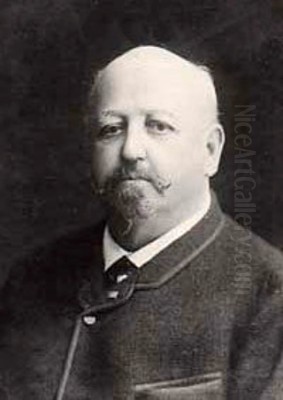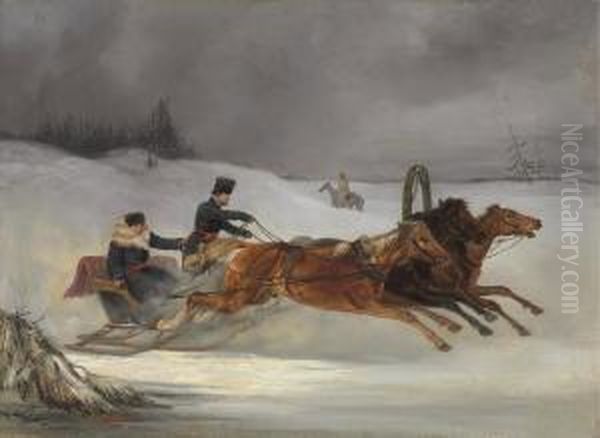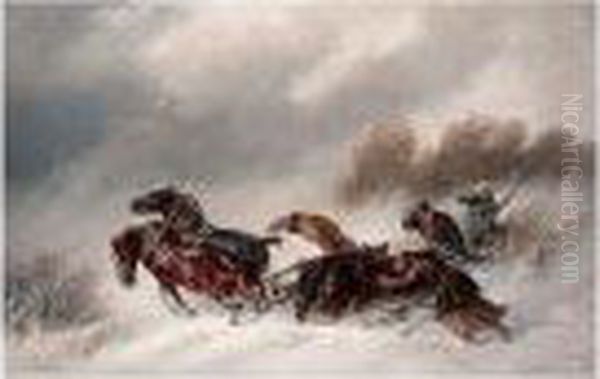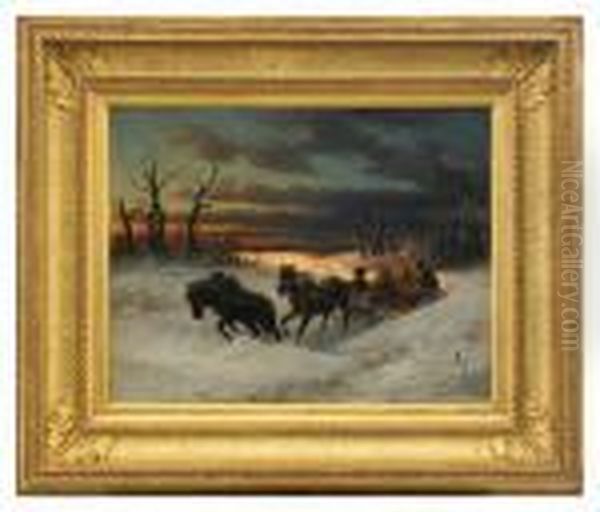
Nikolai Egorovich Sverchkov stands as a significant figure in 19th-century Russian art, celebrated primarily for his mastery in depicting horses and vibrant scenes of Russian life. Living from 1817 to 1898, his career spanned a dynamic period in Russian cultural history, witnessing the transition from Neoclassicism towards Realism. Sverchkov carved a unique niche for himself as one of the nation's foremost animalier painters, earning acclaim both domestically and internationally. His works offer a vivid window into the world of equine beauty, the thrill of the hunt, the challenges of travel, and the distinct atmosphere of Russia, particularly its evocative winters.
Humble Beginnings and Artistic Awakening
Nikolai Sverchkov was born in St. Petersburg in 1817. His origins were modest; his father served as a coachman and later worked in the Imperial stables. This early exposure to the world of horses undoubtedly planted the seeds for his lifelong artistic passion. Growing up surrounded by these magnificent animals, he developed an intimate understanding of their form, movement, and temperament long before he formally picked up a brush.
Unlike many prominent artists of his time who followed a structured path through the Imperial Academy of Arts from a young age, Sverchkov's initial artistic development was less conventional. Sources suggest he was largely self-taught in his formative years, honing his skills through observation and practice. He reportedly spent time sketching the horses he saw daily, developing a keen eye for anatomical accuracy and capturing their inherent energy. This hands-on, observational approach likely contributed to the remarkable vitality and authenticity that would later characterize his work.
Despite the lack of early formal training, Sverchkov's innate talent could not be ignored. He did attend classes at the Academy's educational school for a period, but his primary education came from life itself. His dedication and skill eventually led him to seek recognition from the established art world.
Gaining Recognition and Academic Honours

Sverchkov's persistence paid off. Around 1839, his talent was acknowledged by the Imperial Academy of Arts in St. Petersburg, which granted him the title of "Free Artist." This designation, often given to talented individuals who hadn't completed the full academic course, allowed him to work independently while acknowledging his artistic merit. It was a crucial step, legitimizing his status as a professional painter.
His reputation grew steadily, particularly for his exceptional ability to paint horses. This was a highly valued skill in a society where horses played a vital role in transportation, military affairs, agriculture, and aristocratic leisure pursuits like hunting and racing. Sverchkov's depictions were noted for their realism, dynamism, and empathetic understanding of the animals.
His rising stature culminated in further academic accolades. In 1852, the Imperial Academy of Arts awarded him the prestigious title of Academician for his painting "Landowner's Troika Horses at the Porch." This honour solidified his position within the upper echelons of the Russian art establishment. Just three years later, in 1855, he was elevated to the rank of Professor at the Academy, recognizing not only his artistic skill but also his potential contribution to art education, particularly in the specialized field of animal painting.
The Reigning Subject: The Horse
The horse was undeniably the central motif of Nikolai Sverchkov's artistic universe. His deep familiarity with the subject, stemming from his childhood, allowed him to portray horses with an unparalleled combination of anatomical precision and expressive freedom. He painted horses in nearly every conceivable context relevant to Russian life.
He created stunning portraits of specific, often famous, purebred horses, particularly Orlov Trotters and other breeds favoured by the Russian aristocracy and studs like Khrenovsky and Chesmensky. These were not mere anatomical studies; Sverchkov captured the individual character and spirit of each animal, highlighting their sleek lines, powerful musculature, and noble bearing. Works like these were highly sought after by horse breeders and wealthy landowners.
Beyond individual portraits, Sverchkov excelled at depicting horses in motion. His troika scenes are among his most iconic works. He masterfully conveyed the speed and energy of three horses harnessed abreast, pulling a sleigh through snowy landscapes. Paintings like Troika in Winter or variations on the theme capture the quintessential Russian experience of winter travel, often imbued with a sense of urgency or romanticism. The straining muscles of the horses, the flying snow kicked up by their hooves, and the bundled figures in the sleigh are rendered with convincing detail and atmospheric effect.
Hunting Scenes and Equine Narratives

Hunting scenes provided another rich vein for Sverchkov's talents. These compositions often featured multiple figures, horses, and packs of hounds, typically Borzois, engaged in the pursuit of game like wolves or foxes. Works such as Return from the Bear Hunt (1865) showcase his ability to manage complex compositions, depicting the triumphant return of hunters with their quarry, the horses sturdy and reliable, the dogs alert. These scenes appealed greatly to the aristocratic patrons who engaged in such pursuits.
Sverchkov also painted stable interiors, coaching scenes, and military subjects involving cavalry. He understood the relationship between humans and horses, often depicting riders with a natural ease that suggested a strong bond with their mounts. His illustrations for publications like the "Album of Russian Horse Studs" further demonstrated his comprehensive knowledge and dedication to documenting the finest examples of Russian equine breeding. His ability to render the textures of coats, the intricate details of harnesses, and the varied postures of horses—from resting to full gallop—was consistently impressive.
Depicting Russian Life and Landscape
While horses were his specialty, Sverchkov's work extended to broader depictions of Russian life, often intertwined with his equine subjects. His paintings frequently feature peasants, coachmen, landowners, and soldiers, providing glimpses into the social fabric of the time. He was particularly adept at capturing the atmosphere of rural Russia and the distinct character of its seasons.
Winter held a special place in his oeuvre. He masterfully rendered the effects of snow and cold, from crisp, sunny winter days to dramatic blizzards. His snow is palpable – deep drifts, powdery flurries, packed ice on roads. The challenges of travel and survival during the harsh Russian winter are recurring themes, often symbolized by the struggling troika or the lone rider making their way through a vast, snow-covered expanse. These scenes resonated deeply with Russian audiences familiar with such conditions.
His genre scenes, while often centered around horses, captured moments of everyday life: a stop at a coaching inn, peasants tending to their animals, a market day. Though perhaps less overtly focused on social commentary than some of his contemporaries associated with the later Peredvizhniki (Wanderers) movement, Sverchkov's work nonetheless presented an authentic slice of Russian reality, observed with a keen and sympathetic eye.
Style and Technique: Realism with Flair
Sverchkov's artistic style is firmly rooted in Realism. He prioritized accurate observation and detailed rendering. His understanding of anatomy, particularly equine anatomy, was exceptional. He paid close attention to textures – the sheen of a horse's coat, the roughness of peasant clothing, the crispness of snow, the wood grain of a sleigh.

However, his Realism was not merely photographic. He infused his works with dynamism and often a touch of romanticism. His compositions are carefully constructed, often using diagonals to enhance the sense of movement, especially in his troika and hunting scenes. His use of light and colour effectively conveys mood and atmosphere, from the cold, clear light of a winter morning to the dramatic contrasts of a snowstorm.
Compared to the strict academicism that dominated the earlier part of the 19th century, exemplified by artists like Karl Bryullov with his historical epics, Sverchkov's focus on contemporary Russian life and his realistic approach aligned with the broader shifts occurring in Russian art. Yet, his specialization set him apart from the mainstream genre painters like Pavel Fedotov or the later critical realists of the Wanderers movement.
Esteemed Patronage and International Acclaim
Sverchkov's talent did not go unnoticed by the highest echelons of society. He enjoyed significant patronage from the Russian Imperial family. Both Tsar Nicholas I and his successor, Tsar Alexander II, commissioned works from him. These often included portraits of the Tsars themselves, sometimes depicted on horseback or in sleighs, as well as paintings documenting imperial hunts and favourite horses from the royal stables.
His fame extended beyond Russia's borders. Sverchkov actively exhibited his work internationally, participating in prestigious shows in Paris, London, and Brussels. His depictions of spirited horses and uniquely Russian scenes captivated European audiences. A notable mark of international recognition came in 1863 when he was awarded the Cross of the Legion of Honour in France, presented to him personally by Emperor Napoleon III, who was reportedly an admirer of his work and even acquired some of his paintings. This award was a significant achievement for a Russian artist at the time.
This international exposure placed him in the company of other renowned European animal painters, such as Rosa Bonheur in France and Sir Edwin Landseer in Britain, though Sverchkov's style and subject matter remained distinctly Russian.
Sverchkov in the Context of 19th-Century Russian Art
To fully appreciate Sverchkov's contribution, it's helpful to place him within the vibrant and evolving landscape of 19th-century Russian art. He worked during a period of intense artistic exploration and national self-discovery. The early part of his career coincided with the lingering influence of Neoclassicism and Romanticism, dominated by the Imperial Academy of Arts and figures like the aforementioned Karl Bryullov.
However, the mid-century saw the rise of Realism and genre painting. Artists like Pavel Fedotov began turning towards satirical and sympathetic depictions of everyday Russian life. This trend gained momentum and eventually led to the formation of the Society for Travelling Art Exhibitions (Peredvizhniki or Wanderers) in the 1870s. This influential group, including masters like Ivan Kramskoi, Vasily Perov, Ilya Repin, Vasily Surikov, and the landscape painters Ivan Shishkin and Isaac Levitan, championed Realism, often with a focus on social issues, Russian history, and the beauty of the native landscape.
Sverchkov operated somewhat parallel to the core Peredvizhniki movement. While sharing their commitment to Realism and Russian themes, his focus remained more specialized on animal painting and scenes of aristocratic or traditional life (like hunts and troika rides), rather than the often critical social commentary found in the works of Perov or Repin. He maintained strong ties to the Academy and aristocratic patrons, whereas the Wanderers often defined themselves in opposition to the academic establishment.
Nonetheless, Sverchkov's dedication to depicting Russian reality connects him to the broader Realist spirit of the age. His work complements that of landscape specialists like Shishkin or the great marine painter Ivan Aivazovsky, each contributing to a multifaceted portrayal of Russia. Even later artists like Valentin Serov, known for his brilliant society portraits, also explored rural themes and occasionally depicted horses with great skill, perhaps indirectly benefiting from the tradition Sverchkov had helped solidify. Another contemporary known for historical and battle scenes often featuring horses was Bogdan Willewalde. The Polish-Russian painter Józef Brandt, though working slightly later and often focusing on Polish or Cossack history, shared a similar interest in dynamic equestrian scenes.
Later Years and Enduring Legacy
Nikolai Sverchkov remained active as an artist for most of his long life. He continued to paint the subjects he loved, refining his skills and producing a substantial body of work. He passed away in Tsarskoye Selo, the imperial residence near St. Petersburg, in 1898, at the age of 81.
His legacy is significant, particularly within the realm of Russian art. He is widely regarded as one of the founders, if not the preeminent master, of the Russian school of animal painting. He elevated the genre beyond mere illustration, creating works of genuine artistic merit and emotional resonance. His influence can be seen in subsequent generations of Russian artists who depicted animals and rural life.
Today, Sverchkov's paintings are held in major Russian museums, including the State Tretyakov Gallery in Moscow, the State Russian Museum in St. Petersburg, and the Museum of Horse Breeding in Moscow, as well as in numerous private collections worldwide. His works continue to be appreciated for their technical brilliance, their dynamic portrayal of horses, and their evocative depiction of 19th-century Russia.
Market Presence and Collectibility
Reflecting his historical importance and enduring appeal, works by Nikolai Sverchkov regularly appear on the art market at international auctions. Prices vary significantly depending on the size, subject matter, period, condition, and provenance of the piece. Major works, particularly large, well-executed troika or hunting scenes, or those with imperial provenance, can command substantial sums, often reaching tens or even hundreds of thousands of dollars or euros. Smaller studies, drawings, or less complex compositions are naturally more accessible.
His consistent presence in auctions held by major houses like Sotheby's and Christie's, as well as specialized Russian art sales, attests to his established status among collectors of 19th-century Russian art. The estimates and sale prices achieved for works like "Stable Friends" or various troika scenes confirm his solid position in the market, valued for both their artistic quality and historical significance.
Conclusion: An Artist of Horse and Homeland
Nikolai Egorovich Sverchkov dedicated his life to capturing the spirit of the horse and the essence of the Russian scene. From humble beginnings, his innate talent and deep connection to his subjects propelled him to the heights of academic recognition and international fame. His paintings of powerful Orlov Trotters, thrilling troika rides through snowy landscapes, and dramatic hunting expeditions remain iconic images of 19th-century Russia.
While operating alongside the major movements of his time, he carved his own distinct path as Russia's premier animalier. His realistic yet dynamic style, combined with his profound understanding of equine anatomy and his ability to evoke the unique atmosphere of his homeland, ensures his enduring importance. Sverchkov's art offers more than just depictions of animals; it provides a vibrant, authentic, and often exhilarating glimpse into the Russia of a bygone era, forever captured through the eyes of a master observer.